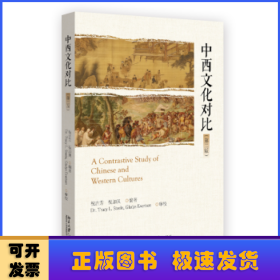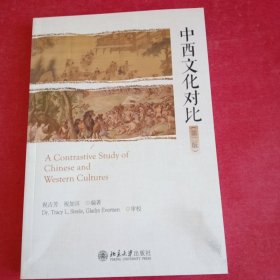
中西文化对比(第2版)
正版保障 假一赔十 可开发票
¥ 52.73 6.0折 ¥ 88 全新
库存95件
广东广州
认证卖家担保交易快速发货售后保障
作者祝吉芳,祝加贝编著
出版社北京大学出版社
ISBN9787301345146
出版时间2023-10
装帧平装
开本16开
定价88元
货号14151393
上书时间2024-05-27
- 最新上架
商品详情
- 品相描述:全新
- 商品描述
-
作者简介
祝吉芳,河海大学教授、河海大学学术委员会委员,长期从事英专本科及英专研究生的跨文化交际、中国文化概论、西方文化入门、中西文化对比、写作、翻译、文学翻译、翻译批评等课程教学。主要著作有:《冲突、碰撞与趋同下的中西文化》(第一版,北京大学出版社)、《英汉翻译:方法与试笔》(北京大学出版社,共三版)、《中国文化经典英语导读》(英语版)(河海大学出版社出版)等。 祝加贝,皖江工学院讲师,长期从事英语专业本科教学以及中西文化比较研究及翻译批评、文学翻译等教学和研究。
目录
Contents Part I.East and West Unit 1 .Why Contrasting Chinese and Western Cultures?.................3 I. Ancient Civilizations and Cultures ................................................................3 II. Cross-cultural Comparative Studies in China ..............................................5 III. Imperatives to Contrast Chinese and Western Cultures ..............................9 IV. A Note on Some Key Concepts .................................................................15 Unit 2 .Characteristics of Traditional Chinese and Western Cultures..............19 I. “There Are All Kinds of Birds in a Large Forest” .......................................19 II. Traditional Chinese Cultural Characteristics ............................................22 III. Traditional Western Cultural Characteristics ............................................32 Unit 3 .Affinities Across Cultures........................................................37 I. Two Unexpected Affinities ..........................................................................38 II. Reading for More Cultural Affinities .........................................................39 III. A Note on Some Key Concepts ................................................................51 Part II Cultural Differences in Silent Language Unit 4 .Time .........................................................................................59 I. Time in China and the West .........................................................................60 II. Two Time Modes ........................................................................................65 III. Past-oriented Societies vs. Future-oriented Societies ...............................73 IV. Two Time Orientations ..............................................................................76 Unit 5 .Space ........................................................................................80 I. What Is Space? ............................................................................................81 II. Spatial Language ........................................................................................82 III. Spatial Language and Culture ...................................................................86 IV. Spatial Language and Life ........................................................................93 Unit 6 .Smiles, Nods and Silence ........................................................97 I. Smiles in Intercultural Communication ......................................................97 II. Nods in Intercultural Communication ......................................................103 III. Silence in Intercultural Communication .................................................105 Part III Cultural Differences in Thinking Unit 7 .Intuitive vs. Logical Thinking..............................................115 I. Definitions of Intuitive and Logical Thinking ............................................116 II. Philosophy and Thinking ..........................................................................117 III. Application of the Two Thinking Modes ................................................121 IV. Impact of Thinking Modes on Writings ..................................................126 V. Logic in China and Intuition in the West ..................................................128 Unit 8 .Dialectical vs. Analytical Thinking......................................132 I. Proverb Preferences Across Cultures ........................................................133 II. Dialectical Thinking .................................................................................134 III. Analytical Thinking ................................................................................139 IV. More about the Two Modes ....................................................................143 Unit 9 .Holistic vs. Atomistic Visions ...............................................146 I. A Detention Room Incident .......................................................................147 II. Prominent Attributes of Holistic and Atomistic Visions ..........................147 III. Vision and Cognition ..............................................................................156 IV. Vision and Language ...............................................................................157 V. Zhengshan Xiaozhong and Lipton Black Tea ..........................................164 Unit 10 .Categorizing Objects by Relationships vs. by Attributes.....167 I. Two Ways to Categorize Objects ...............................................................168 II. Principles to Categorize Objects ..............................................................169 III. How to Categorize Objects and Why .....................................................172 IV. Impacts of Different Ways of Categorization ..........................................175 V. Causal Attribution Patterns Caused by Different Categorization Ways ......178 Unit 11 .Non-controllers vs. Controllers .........................................182 I. Too Early to Tell ........................................................................................183 II. Why So Different Stances Towards Life? ................................................184 III. “Being” and “Doing” Cultures ...............................................................190 IV. Manifestations of “Being” Culture and “Doing” Culture .......................194 Part IV Different Cultural Orientations Unit 12 .The Introvert-oriented vs. the Extrovert-oriented...........205 I. Personality Types .......................................................................................206 II. Personality Types of Cultures ..................................................................208 III. Effects of Personality Types on Pattern Preferences ...............................213 IV. A Contrast of Some Cultural Phenomena ...............................................219 Unit 13 .Collectivism vs. Individualism...........................................225 I. An Embarrassing Custom ..........................................................................225 II. Collectivism and Individualism as Cultural Orientations ........................227 III. Collectivism and Individualism in Cultural Anthropology ....................233 IV. Collectivist and Individualist Perspectives of “Self” ..............................236 V. Interdependence vs. Independence ...........................................................241 Unit 14 .Advocacy of Jing vs. Dong......................................................245 I. Introduction to Two Concepts ...................................................................246 II. Chinese Advocacy of Jing ........................................................................248 III. Western Advocacy of Dong ....................................................................258 IV. Differences and Discomforts ...................................................................263 Unit 15 .Implicitness vs. Explicitness ..............................................267 I. “Half a Story” ............................................................................................268 II. Implicitness vs. Explicitness of Language ...............................................270 III. Implicit Traditional Chinese ...................................................................276 IV. Explicit Westerners .................................................................................284 V. High-context vs. Low-context ..................................................................287 VI. “Chicken and Duck Talk” .......................................................................291 Part V Different Cultural Standards Unit 16 .Peace vs. Conflict ................................................................299 I. Great Names and Different Cultural Standards .........................................300 II. External Factors and Cultural Standards ..................................................305 III. Cultural Standards and Their Unique Products ......................................308 IV. Better Ways to Know Each Other ...........................................................313 Unit 17 .Egalitarian vs. Inegalitarian Distribution .......................316 I. Hate-the-rich Mentality .............................................................................316 II. Traditional Chinese-style Egalitarianism .................................................318 III. Western-style Inegalitarianism ................................................................321 IV. Egalitarianism and Inegalitarianism in China and the West ...................323 Unit 18 .Good vs. Evil Human Nature ............................................326 I. Definition of Two Concepts .......................................................................326 II. Human Nature and Education ..................................................................328 III. Theorization of Assumptions about Human Nature ...............................331 IV. Human Nature Theories and the Rule of Ethics vs. Law ........................337 Unit 19 .Rule of Individuals vs. Rule of Law ..................................339 I. Rule of Individuals in Traditional Chinese Thought .................................339 II. Rule of Law in Traditional Western Thought ...........................................345 III. Rule of Law in China Today ...................................................................350
内容摘要
这是一部以本科生和研究生为主要对象、专门比较传统中西文化的“中西文化对比”课程英语教材。教材共分五个部分:I、传统上的“东”与“西”(相当于绪论)
相关推荐
— 没有更多了 —





















以下为对购买帮助不大的评价